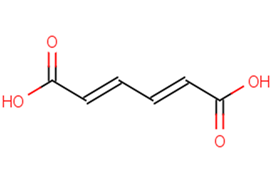
trans-trans-Muconic acid
CAS No. 3588-17-8
trans-trans-Muconic acid( —— )
Catalog No. M20676 CAS No. 3588-17-8
trans-trans-Muconic acid is a urinary metabolite of benzene.
Purity : >98% (HPLC)
 COA
COA
 Datasheet
Datasheet
 HNMR
HNMR
 HPLC
HPLC
 MSDS
MSDS
 Handing Instructions
Handing Instructions
| Size | Price / USD | Stock | Quantity |
| 100MG | 38 | In Stock |


|
| 200MG | Get Quote | In Stock |


|
| 500MG | Get Quote | In Stock |


|
| 1G | Get Quote | In Stock |


|
Biological Information
-
Product Nametrans-trans-Muconic acid
-
NoteResearch use only, not for human use.
-
Brief Descriptiontrans-trans-Muconic acid is a urinary metabolite of benzene.
-
Descriptiontrans-trans-Muconic acid is a urinary metabolite of benzene.
-
In Vitro——
-
In Vivo——
-
Synonyms——
-
PathwayProteasome/Ubiquitin
-
TargetEndogenous Metabolite
-
RecptorHuman Endogenous Metabolite
-
Research Area——
-
Indication——
Chemical Information
-
CAS Number3588-17-8
-
Formula Weight142.11
-
Molecular FormulaC6H6O4
-
Purity>98% (HPLC)
-
SolubilityDMSO:28 mg/mL (197.03 mM)
-
SMILESOC(=O)\C=C\C=C\C(O)=O
-
Chemical Name——
Shipping & Storage Information
-
Storage(-20℃)
-
ShippingWith Ice Pack
-
Stability≥ 2 years
Reference
1.Soleimani E Bahrami A Afkhami A et al. Determination of urinary transtrans-muconic acid using molecularly imprinted polymer in microextraction by packed sorbent followed by liquid chromatography with ultraviolet detection[J]. Journal of Chromatography B 2017:S1570023217308012.
molnova catalog



related products
-
Cytosine
Cytosine is a pyrimidine base that is a fundamental unit of nucleic acids. The deamination of cytosine alone is apparent and the nucleotide of cytosine is the prime mutagenic nucleotide in leukaemia and cancer.
-
5-Methoxyindole-3-ac...
5-Methoxyindole-3-acetic acid is a metabolite of Melatonin and is isolated from pineal tissue.
-
Magnesium acetate te...
Magnesium acetate tetrahydrate is the hydrated form of the anhydrous magnesium acetate salt.Magnesium acetate tetrahydrate is commonly used to synthesize other compounds, cocoa as an electrolyte supplement or as a reagent in molecular biology experiments.



 Cart
Cart
 sales@molnova.com
sales@molnova.com


